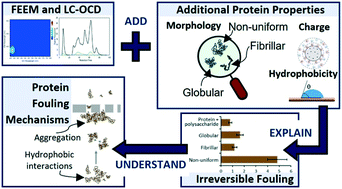Considerations of the limitations of commonly applied characterisation methods in understanding protein-driven irreversible fouling†
Abstract
The utility of advanced organic characterisation techniques including fluorescence excitation emission matrix (FEEM) spectroscopy and liquid chromatography with organic carbon detection (LC-OCD) to indicate irreversible protein fouling of ultrafiltration (UF) membranes was assessed for uniform globular protein (bovine serum albumin (BSA)), non-uniform protein (algal protein), fibrillar protein (fish gelatine), and protein–polysaccharide (BSA–sodium alginate) mixtures. The properties of the proteins and protein–polysaccharide mixtures were distinguished using FEEM, LC-OCD, contact angle, and zeta potential. A combination of protein size, morphology, physicochemical forces, and interaction with polysaccharides was found to influence membrane fouling, with the most severe irreversible fouling to the development of algal protein aggregates due to partially unfolded globular protein macromolecules. These non-uniform structures in algal protein interacted via hydrophobic interactions leading to supersaturated aggregation on the membrane surface. The uniform globular protein, BSA, did not aggregate and displayed low fouling due to its stability and small macromolecular size. Fibrillar protein displayed low fouling due to hydrophobic and electrostatic interactions that led to low gelation between protein fibrils. FEEM and LC-OCD were able to provide potential insights into protein fouling behaviour resulting from protein aggregation and changes to protein fouling due to the presence of polysaccharides. However, an extended assessment of hydrophobic and electrostatic interactions using contact angle and zeta potential, respectively, with additional details on the protein's morphology was required to evaluate fouling mechanisms associated with all proteins and protein–polysaccharide mixtures. This study demonstrates the need for a broader characterisation and assessment of proteinaceous UF foulants, particularly high-fouling non-uniform or denatured proteins.



 Please wait while we load your content...
Please wait while we load your content...